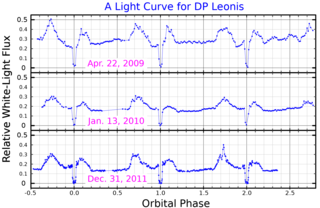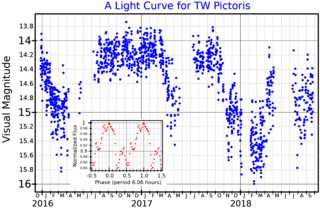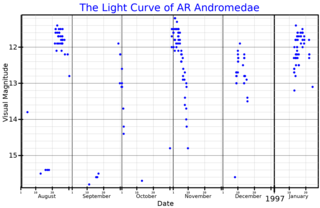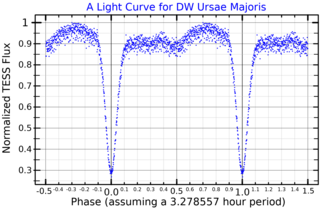
In astronomy, cataclysmic variable stars (CVs) are stars which irregularly increase in brightness by a large factor, then drop back down to a quiescent state. They were initially called novae, since ones with an outburst brightness visible to the naked eye and an invisible quiescent brightness appeared as new stars in the sky.

DQ Herculis, or Nova Herculis 1934, was a slow, bright nova occurring in the northern constellation of Hercules in December 1934. This cataclysmic variable star was discovered on 13 December 1934 by J. P. M. Prentice from Stowmarket, Suffolk. It reached peak brightness on 22 December 1934 with an apparent magnitude of 1.5. The nova remained visible to the naked eye for several months.

In astronomy, an intermediate polar is a type of cataclysmic variable, binary star system with a white dwarf and a cool main-sequence secondary star. In most cataclysmic variables, matter from the companion star is gravitationally stripped by the compact star and forms an accretion disk around it. In intermediate polar systems, the same general scenario applies except that the inner disk is disrupted by the magnetic field of the white dwarf.

In astronomy, a polar is a highly magnetic type of cataclysmic variable (CV) binary star system, originally known as an AM Herculis star after the prototype member AM Herculis. Like other CVs, polars contain two stars: an accreting white dwarf (WD), and a low-mass donor star which is transferring mass to the WD as a result of the WD's gravitational pull, overflowing its Roche lobe. Polars are distinguished from other CVs by the presence of a very strong magnetic field in the WD. Typical magnetic field strengths of polar systems are 10 million to 80 million gauss. The WD in the polar AN Ursae Majoris has the strongest known magnetic field among cataclysmic variables, with a field strength of 230 million gauss.

AM Herculis is a binary variable star located in the constellation Hercules. This star, along with the star AN Ursae Majoris, is the prototype for a category of cataclysmic variable stars called polars, or AM Her type stars.
A luminous supersoft X-ray source is an astronomical source that emits only low energy X-rays. Soft X-rays have energies in the 0.09 to 2.5 keV range, whereas hard X-rays are in the 1–20 keV range. SSSs emit few or no photons with energies above 1 keV, and most have effective temperature below 100 eV. This means that the radiation they emit is highly ionizing and is readily absorbed by the interstellar medium. Most SSSs within our own galaxy are hidden by interstellar absorption in the galactic disk. They are readily evident in external galaxies, with ~10 found in the Magellanic Clouds and at least 15 seen in M31.

DP Leonis is a binary star system in the equatorial constellation of Leo. It is a variable star that ranges in apparent visual magnitude from 17.5 down to 19. The system is located at a distance of approximately 990 light-years from the Sun based on parallax. It is a cataclysmic variable star of the AM Herculis-type also known as polars. The system comprises an eclipsing white dwarf and red dwarf in tight orbit and an extrasolar planet. This eclipsing variable was discovered by P. Biermann and associates in 1982 as the optical counterpart to the EINSTEIN X-ray source E1114+182.

AN Ursae Majoris is a binary star system in the northern circumpolar constellation of Ursa Major. It is a variable star, with AN Ursae Majoris being the variable star designation, and ranges in brightness from 14.90 down to 20.2. Even at its peak brightness though, the system is much too faint to be visible to the naked eye. Based on parallax measurements, the system is located roughly 1,050 light years away from the Sun.

TW Pictoris is a 14th magnitude cataclysmic variable star system in the southern constellation of Pictor. It is located at a distance of approximately 1,430 light-years based on parallax measurements. Photometric observations in the visual band suggest a binary system with an orbital period of 6.06 hours. One of the components is an accreting white dwarf.

QS Telescopii is a faint, well-studied binary star system in the southern constellation Telescopium. It is composed of a white dwarf and main sequence donor star, locked into a close, circular orbit facing one another. Known as polars, material from the donor star does not form an accretion disk around the white dwarf, but rather streams directly onto it. This is due to the presence of the white dwarf's strong magnetic field. The pair undergo frequent shifts between a high and low accretion states, and it shifts between single and double accretion poles. The main pole is partially self-eclipsing.

SU Ursae Majoris, or SU UMa, is a close binary star in the northern circumpolar constellation of Ursa Major. It is a periodic cataclysmic variable that varies in magnitude from a peak of 10.8 down to a base of 14.96. The distance to this system, as determined from its annual parallax shift of 4.53 mas, is 719 light-years. It is moving further from the Earth with a heliocentric radial velocity of +27 km/s.

AR Andromedae is a dwarf nova of the SS Cygni type in the constellation Andromeda. Its typical apparent visual magnitude is 17.6, but increases up to 11.0 magnitude during outbursts. The outbursts occur approximately every 23 days.

UZ Fornacis is a binary star in the constellation of Fornax. It appears exceedingly faint with a maximum apparent magnitude 17.0. Its distance, as measured by Gaia using the parallax method, is about 780 light-years.

UX Ursae Majoris is an Algol type binary star system in the northern circumpolar constellation of Ursa Major. It is classified as a nova-like variable star similar to DQ Herculis, although no eruptions have been reported. Since its discovery in 1933, this system has been the subject of numerous studies attempting to determine its properties. The combined apparent visual magnitude of UX UMa ranges from 12.57 down to 14.15. The system is located at a distance of approximately 952 light years from the Sun based on parallax, and is drifting further away with a radial velocity of 112 km/s.

BZ Ursae Majoris is a dwarf nova star system in the northern circumpolar constellation of Ursa Major. It consists of a white dwarf primary in a close orbit with a red dwarf. The latter star is donating mass, which is accumulating in an accretion disk orbiting the white dwarf. The system is located at a distance of approximately 505 light years from the Sun based on parallax measurements.

BG Canis Minoris is a binary star system in the equatorial constellation of Canis Minor, abbreviated BG CMi. With an apparent visual magnitude that fluctuates around 14.5, it is much too faint to be visible to the naked eye. Parallax measurements provide a distance estimate of approximately 2,910 light years from the Sun.

QQ Vulpeculae is a cataclysmic variable binary star system in the northern constellation of Vulpecula, abbreviated QQ Vul. It has a brightness that fluctuates around an apparent visual magnitude of 14.7, which is too faint to be viewed with the naked eye. The distance to this system is approximately 981 light years based on parallax measurements.

SW Ursae Majoris is a cataclysmic binary star system in the northern circumpolar constellation of Ursa Major, abbreviated SW UMa. During quiescence it has an apparent visual magnitude of 16.5–17, which is too faint to be visible to the naked eye. Based on parallax measurements, it is located at a distance of approximately 526 light years from the Sun.

DW Ursae Majoris is an eclipsing binary star system in the northern circumpolar constellation of Ursa Major, abbreviated DW UMa. It is a cataclysmic variable of the SX Sextanis type, consisting of a compact white dwarf that is accreting matter from an orbiting companion star. The brightness of this source ranges from an apparent visual magnitude of 13.6 down to magnitude 18, which is too faint to be viewed with the naked eye. The distance to this system is approximately 1,920 light years based on parallax measurements.

YY Draconis and DO Draconis are separate identifiers for what is likely the same cataclysmic variable system in the northern constellation of Draco, abbreviated YY Dra and DO Dra, respectively. The DO Dra binary star system is classified as a U Geminorum variable that ranges in luminosity from an apparent visual magnitude of 10.0 down to 15.1. It is located at a distance of approximately 639 light years from the Sun.



















